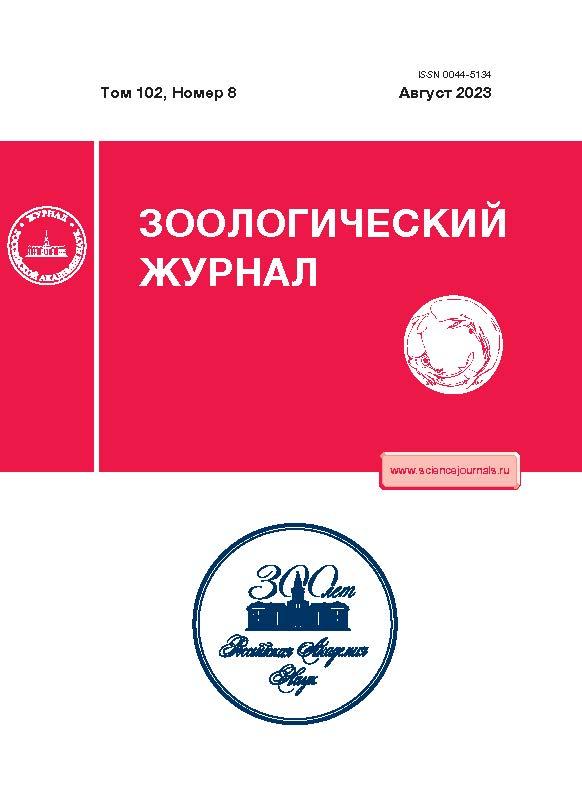BIOLOGICAL CHARACTERISTICS AND FOOD COMPOSITION OF THE SHRIMP, SABINEA SEPTEMCARINATA (SABINE 1824) (CRUSTACEA, CRANGONIDAE) FROM THE SHELF OF THE KARA AND LAPTEV SEAS
- Authors: Kobiakov K.A.1
-
Affiliations:
- Kaliningrad Technical Institute
- Issue: Vol 102, No 8 (2023)
- Pages: 860-870
- Section: Articles
- URL: https://journals.rcsi.science/0044-5134/article/view/136818
- DOI: https://doi.org/10.31857/S0044513423080068
- EDN: https://elibrary.ru/YBVAOG
- ID: 136818
Cite item
Abstract
The size and sex structure, the dependence of the state of the gonads of females on the size of the individual, and the composition of the food of the shrimp, Sabinea septemcarinata (Sabine 1824) (Crustacea, Crangonidae) from the Laptev Sea, the Khatanga Bay and the Kara Sea are described (598 individuals: 230 of them had empty stomachs, 368 contained food in their stomachs, and 34 had them full). The shrimps were collected in August–September 2016. The total body length of the shrimps examined varied from 31 to 103 mm: 32–103 mm in females and 31–74 mm in males. The lifespan seems to last 3–4 years in females, vs 2–3 years in males. Based on the condition of the gonads of the females, the time of material collection coincided with spawning. Among the females there are individuals at all stages of the reproductive cycle: feeding, spawning and preparing for the next spawning. This indicates extended population spawning. Sabinea septemcarinata belongs to the life form of burrowing shrimp. According to the frequency of occurrence in the stomachs, detritus takes the first place (92.2%). The second and third places are taken up by cumin crayfish and sedentary polychaetes, which occur in almost every second and third stomach (frequency of occurrence 37.7 and 23.9%, respectively). Sand shows a frequency of occurrence of 50.3%. In the virtual food lump, a little more than a third of its volume is taken up by detritus (39.7%), followed by cumin crayfish and polychaetes that take second and third places (23.6 and 22.6%, respectively). Consequently, S. septemcarinata feed on infauna. Thus, S. septemcarinata are characterized by elements of an attacking predator and a detritophage.
About the authors
K. A. Kobiakov
Kaliningrad Technical Institute
Author for correspondence.
Email: kir.321@mail.ru
Russia, 236022, Kaliningrad
References
- Буруковский Р.Н., 1992. Методика биологического анализа некоторых тропических и субтропических креветок // Промыслово-биологические исследования морских беспозвоночных. М.: ВНИРО. С. 77–84.
- Буруковский Р.Н., 2009. Питание и пищевые взаимоотношения креветок. Калининград: Издательство ФГОУ ВПО “КГТУ”. 408 с.
- Буруковский Р.Н., 2010. Зоология беспозвоночных. СПб.: Проспект науки. 960 с.
- Буруковский Р.Н., 2017. Креветки западноафриканских вод (географическое распространение, закономерности горизонтального и вертикального распределения, жизненные формы и экологическая структура таксоценов). СПб.: Проспект науки. 512 с.
- Буруковский Р.Н., 2022. Креветки: состав пищи и пищевые взаимоотношения. СПб.: Проспект науки. 567 с.
- Буруковский Р.Н, Трунова А.В., 2007. О питании креветки Crangon crangon (Decapoda, Crangonidae) в Кандалакшском заливе Белого моря в июле и сентябре 2004 года // Морские промысловые беспозвоночные и водоросли (биология и промысел). К 70-летию со дня рождения Иванова Б.Г. Т. 147. С. 181–203.
- Гуков А.Ю., 2013. Экология донных биоценозов морей Лаптевых и Восточно-Сибирского. Дис. … докт. биол. наук. Якутск: Федеральное государственное бюджетное учреждение “Государственный природный заповедник “Усть-Ленский””. 417 с.
- Кузнецов В.В., 1964. Биология массовых видов ракообразных Баренцева и Белого морей. Акад. наук СССР. Зоол. ин-т. Москва; Ленинград: Наука. [Ленингр. отд-ние]. 242 с.
- Марин И.Н., 2013. Малый атлас десятиногих ракообразных России. М.: Товарищество научных изданий КМК. 145 с.
- Петелин В.П., 1967. Гранулометрический анализ морских донных осадков. М.: Наука. 128 с.
- Соколов В.И., 2001. Десятиногие ракообразные (Crustacea Decapoda) евразийских морей полярного бассейна. М.: Всероссийский научно-исследовательский институт рыбного хозяйства и океанографии ВНИРО. 344 с.
- Яшнов В.А., 1948. Тип Arthropoda, отряд Ostracoda, Copepoda. Cumacea, Isopoda, Amphipoda, Decapoda // Определитель фауны и флоры северных морей СССР / под ред. Н.С. Гаевской. М.: Советская наука. 737 с.
- Cartes J.E., Sarda F., 1989. Feeding ecology of the deep–water aristeid crustacean Aristeus antennatus // Marine Ecology Progress Series. V. 54. P. 229–238.
- Williams A.B., 1984. Shrimps, lobsters, and crabs of the Atlantic coast of the Eastern United States, Maine to Florida. Smithsonian institution press, Washington, D.C. 550 p.
Supplementary files











